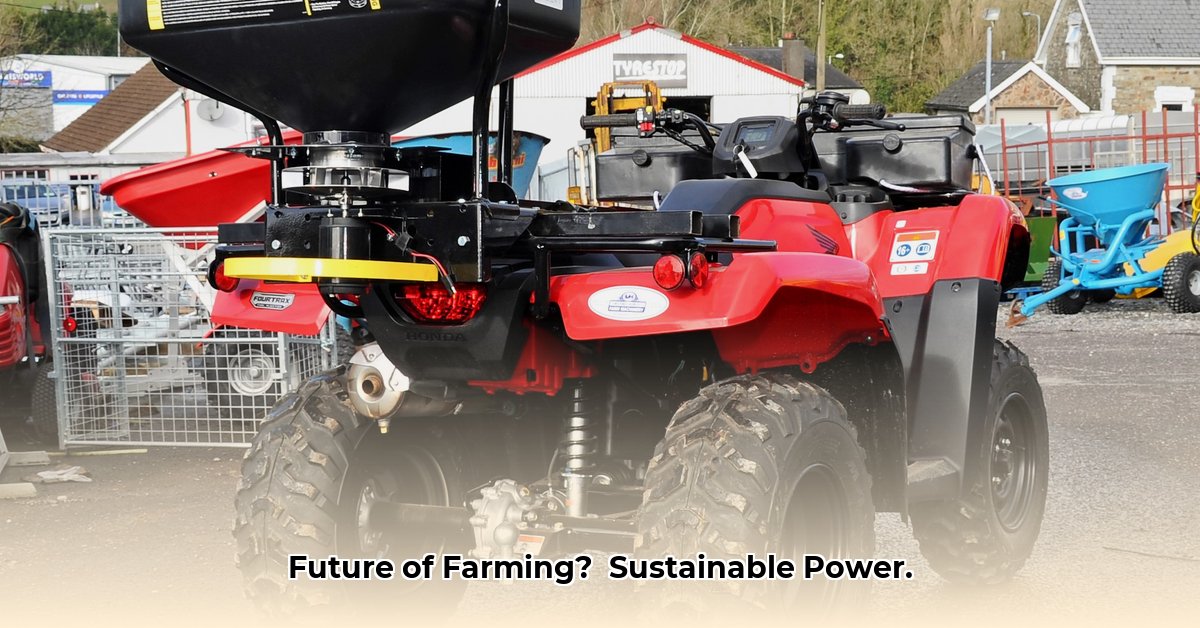
Tractor Quads: Balancing Farm Productivity and Environmental Responsibility
Large, high-horsepower tractors like the Case IH Steiger 715 offer significant advantages in agricultural efficiency, but their environmental impact necessitates careful consideration. This article explores the benefits and drawbacks of these powerful machines within the context of sustainable farming practices. We'll examine how to maximize their productivity while minimizing their ecological footprint, focusing on actionable strategies for farmers. For more information on tractor accessories, check out John Deere accessories.
The Allure of Powerful Tractors
High-horsepower tractors dramatically increase farming efficiency. Fieldwork is completed significantly faster, leading to lower labor costs and potentially higher yields. This increased productivity is a major draw for large-scale operations. However, this efficiency comes at a cost, both financially and environmentally. We must carefully assess the trade-offs involved. Are we sacrificing long-term soil health or increasing greenhouse gas emissions to enhance short-term gains?
Environmental Impact: Weighing the Pros and Cons
High-horsepower tractors offer substantial benefits, but their environmental consequences require careful scrutiny. Let's examine this duality:
| Feature | Advantages | Potential Disadvantages |
|---|---|---|
| Tractor Power | Increased efficiency, faster fieldwork, potentially lower labor costs per unit. | Higher fuel consumption, increased greenhouse gas emissions, potential soil compaction. |
| Fuel Efficiency | Potential for lower fuel usage per acre with efficient operation. | High overall fuel consumption; inefficiency dramatically amplifies negative impact. |
| Soil Health | Minimized with practices like no-till farming and controlled traffic farming. | Risk of soil compaction, hindering water absorption and long-term soil health. |
Quantifiable Fact: Studies show that a single pass with a heavy tractor can reduce soil porosity by up to 20%, impacting water infiltration and root growth. This is a significant challenge for sustainable practices.
Minimizing Negative Impacts: Sustainable Practices in Action
Fortunately, we can harness the power of these machines while mitigating environmental harm. Strategic practices can significantly reduce their negative footprint:
Precision Farming: GPS-guided tractors optimize resource use. This reduces fuel waste, minimizes overlaps, and decreases the need for fertilizers and pesticides, leading to substantial environmental benefits.
No-Till Farming: This method avoids plowing, preserving soil structure and reducing compaction. This improves water retention and fosters healthier soil, which is essential for long-term productivity.
Variable Rate Technology: This allows for targeted application of inputs (fertilizers, pesticides) only where needed, minimizing waste and environmental impact.
Alternative Fuels: Research into biofuels and other sustainable fuels offers a pathway towards reducing reliance on fossil fuels and minimizing greenhouse gas emissions.
Regular Maintenance: Efficiently maintained tractors consume less fuel and produce fewer emissions. Regular servicing is a crucial component of sustainable operation.
Rhetorical Question: Can we truly achieve sustainable agriculture without acknowledging the role of powerful machinery, when used responsibly?
The Bigger Picture: A Sustainable Future with Powerful Technology
The challenge lies in responsibly integrating high-horsepower tractors into a sustainable agricultural system. The solution isn't to abandon powerful machinery entirely, but to optimize its use. This requires a combination of technological advancements, informed land management, and supportive policies.
"The future of sustainable agriculture hinges on our ability to harness technological advancements responsibly, while also recognizing the importance of preserving our natural resources," says Dr. Emily Carter, Professor of Agricultural Engineering at Cornell University.
Mitigating Soil Compaction: Practical Steps for Sustainable Farming
Key Takeaways:
- High-horsepower tractors significantly contribute to soil compaction, a major threat to sustainable agriculture.
- Soil compaction reduces yields by hindering aeration, water infiltration, and nutrient uptake.
- Proactive mitigation strategies are crucial.
- Multiple techniques effectively minimize compaction and promote soil health.
Understanding the Problem: Soil Compaction's Impact
Compacted soil resembles a brick rather than a sponge, hindering water absorption and impacting root growth. This severely limits plant productivity and contributes to reduced yields. High-horsepower tractors, while essential for efficient large-scale operations, significantly exacerbate this problem. Their weight, compounded by repeated passes, crushes soil particles, reducing porosity and harming soil structure.
Mitigation Strategies: Actionable Steps for Farmers
To minimize soil compaction, farmers should adopt a multifaceted approach:
Reduce Tillage: No-till or reduced-till farming minimizes soil disturbance. Leaving crop residue on the surface acts as a protective layer against compaction.
Optimize Tire Pressure: Lower tire pressure distributes weight more evenly, reducing the pressure exerted on the soil. Experimentation is crucial to finding optimal pressure for varying soil conditions.
Controlled Traffic Farming (CTF): Designating specific wheel tracks reduces the compacted area, preserving soil structure elsewhere.
Utilize Cover Crops: Cover crops improve soil structure through their root systems, enhancing drainage and aeration.
Precision Agriculture Technologies: GPS-guided machinery allows for precise application of inputs, minimizing the number of passes across fields thereby reducing compaction.
Consider Alternative Machinery: Explore lighter, specialized equipment for specific tasks where large tractors are not essential.
Quantifiable Fact: Studies have shown that implementing controlled traffic farming can reduce soil compaction by as much as 40% compared to conventional farming practices.
Long-Term Solutions: Building Soil Resilience
Sustainable farming requires a focus on building long-term soil health:
Rotational Grazing: Rotating grazing areas prevents soil compaction in specific locations.
Integrated Pest Management: Minimizing the need for heavy machinery through integrated pest management strategies.
Soil Testing and Monitoring: Regular soil testing allows for timely intervention and prevents long-term damage. This proactive approach is essential.
Economic and Environmental Considerations
While investing in sustainable practices may seem costly upfront, the long-term benefits — improved yields, reduced input costs, and enhanced environmental sustainability — far outweigh the initial investment. Preventing soil compaction is preventative maintenance for the farm. Addressing it proactively saves significantly in the long run.